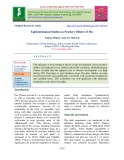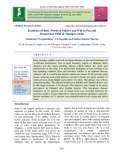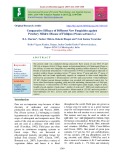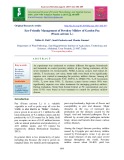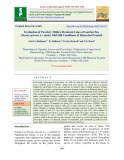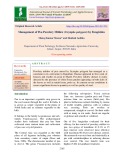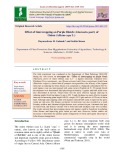
Pea powdery mildew
-
The influence of environmental factors on the development of pea powdery mildew (Erysiphe pisi) was studied under field conditions. Epidemiological studies revealed that the apparent rate of disease development was high during 50% flowering to pod initiation stage. Powdery mildew severity showed positively and significantly correlated with maximum temperature and sunshine hours. The correlation was non-significant with minimum temperature and relative humidity.
 4p
4p  caygaocaolon8
caygaocaolon8
 07-11-2020
07-11-2020
 12
12
 2
2
 Download
Download
-
Rust, powdery mildew and wilt are major diseases of pea and broad bean of worldwide distribution. Due to high humidity region of Manipur these diseases are the major limiting factors which reduce the yield and productivity of the crop.
 6p
6p  angicungduoc8
angicungduoc8
 07-11-2020
07-11-2020
 9
9
 2
2
 Download
Download
-
Powdery mildew and Rust are major diseases of pea of worldwide distribution. Powdery mildew and Rust is an airborne disease. Powdery mildew is a particularly damaging in late sowing or in late maturity varieties. It is caused by Erysisphe pisi. The disease can cause 20-50% yield losses, reducing total yield biomass, number of pods per plant, number of seeds per pod, plant height and number of nodes. The disease also affects green pea quality. Pea rust is characterized by the appearance of two types of symptoms.
 7p
7p  caygaocaolon6
caygaocaolon6
 30-07-2020
30-07-2020
 14
14
 1
1
 Download
Download
-
The present study was conducted during consecutive Rabi season of year 2014-15 and 2015-16 at farmers field of Village Amethi in Gariyaband district of Chhattisgarh Plains to test efficacy of some new fungicides in controlling powdery mildew diseases of field pea.
 12p
12p  angicungduoc6
angicungduoc6
 20-07-2020
20-07-2020
 9
9
 1
1
 Download
Download
-
An experiment was conducted to evaluate different bio-agents, biorationals and botanicals to control powdery mildew of pea. During evaluation, all the seven treatments viz. hexaconazole, NSKE, Lantana camara leaf extract, B. subtilis, T. harzianum, cow urine, butter milk were found to be significantly superior over control in managing the powdery mildew disease. Among all treatments, T1 (Hexaconazole 5 EC- 0.05%), T2 (NSKE 5%), T5 (T. harzianum 0.4%), T6 (cow urine 10%), T3 (Lantana camara leaves extract 10%) were significantly superior over other treatments for managing powdery mildew.
 6p
6p  nguaconbaynhay6
nguaconbaynhay6
 24-06-2020
24-06-2020
 12
12
 0
0
 Download
Download
-
Field study consisting of seven lines viz., APL-55, APL-69, APL-80, APL-64, APL-84, Line 1-2-SPS5, Line 1-2-SPS11, along with four checks viz., Azad Pea-1, Lincoln, Punjab-89 and Palam Priya was conducted to identify high yielding powdery mildew resistant line(s) under conventional and natural farming conditions at Palampur during rabi seasons 2015-16 and 2016-17.
 10p
10p  trinhthamhodang1213
trinhthamhodang1213
 30-05-2020
30-05-2020
 12
12
 0
0
 Download
Download
-
Powdery mildew (PM) is an important disease of pea that reduce yield. Ascophyllum nodosum extract (ANE) and chitosan (CHT) are biostimulants used to improve plant health. Efficacy of ANE and CHT was assessed individually and in combination against pea powdery mildew.
 10p
10p  viharuno2711
viharuno2711
 21-04-2020
21-04-2020
 12
12
 0
0
 Download
Download
-
Pea powdery mildew is an air-borne disease of worldwide distribution. It is particularly damaging in late sowings or in late maturing varieties. It is caused by Erysiphe pisi. In order to bring residue free peas, there is need to manage these diseases through ecofriendly measures such as by using the chitosan which is antifungal as well as induces resistance in plants. GI chitosan is a deacetylated derivative of chitin obtained by gamma irradiation of chitosan.
 7p
7p  nguaconbaynhay4
nguaconbaynhay4
 22-03-2020
22-03-2020
 14
14
 2
2
 Download
Download
-
Powdery mildew of pea caused by Erysiphe polygoni has emerged as a constraint in its cultivation in Rajasthan. Disease appeared in first week of January and reaches its peak in March. Powdery mildew disease is easily detected by the presence of white floury patches appearing on both sides of the leaves as well as tendril stem, pods etc. In extreme severe conditions it causes significant losses in quantity as well as quality of seed.
 4p
4p  nguaconbaynhay4
nguaconbaynhay4
 22-03-2020
22-03-2020
 13
13
 2
2
 Download
Download
-
Experiments were conducted at Sartingal farm of Regional Horticulture Research Substation (RHRSS) Bhaderwah, Doda, SKUAST-Jammu in randomized block design with eight treatments replicated thrice to assess the losses caused by economically important diseases of pea viz., Ascochyta blight and powdery mildew of pea (Pisum sativum L.). Eight different fungicides and bioagents evaluated as foliar spray, recorded significant reduction against ascochyta blight and powdery mildew disease incidence with a concomitant significant increase in yield over control.
 7p
7p  quenchua2
quenchua2
 16-12-2019
16-12-2019
 8
8
 0
0
 Download
Download
-
The field experiment was conducted at the Department of Plant Pathology SHUATS during the rabi season, to investigate the “Effect of intercropping on purple blotch (Alternaria porri) of onion (Allium cepa L.)” a legume intercrops evaluated were. Chickpea (Cicer arientinum), pea (Pisum sativum), lentil (Lens esculantum), french bean (Phaseolus vulgaris), cluster bean (Cyamopsis tetragonoloba), the efficacy of the legume intercrops in reducing the foliar disease was compared to a fungicide carbendazim (0.1%).
 7p
7p  cothumenhmong1
cothumenhmong1
 08-12-2019
08-12-2019
 17
17
 0
0
 Download
Download
CHỦ ĐỀ BẠN MUỐN TÌM









